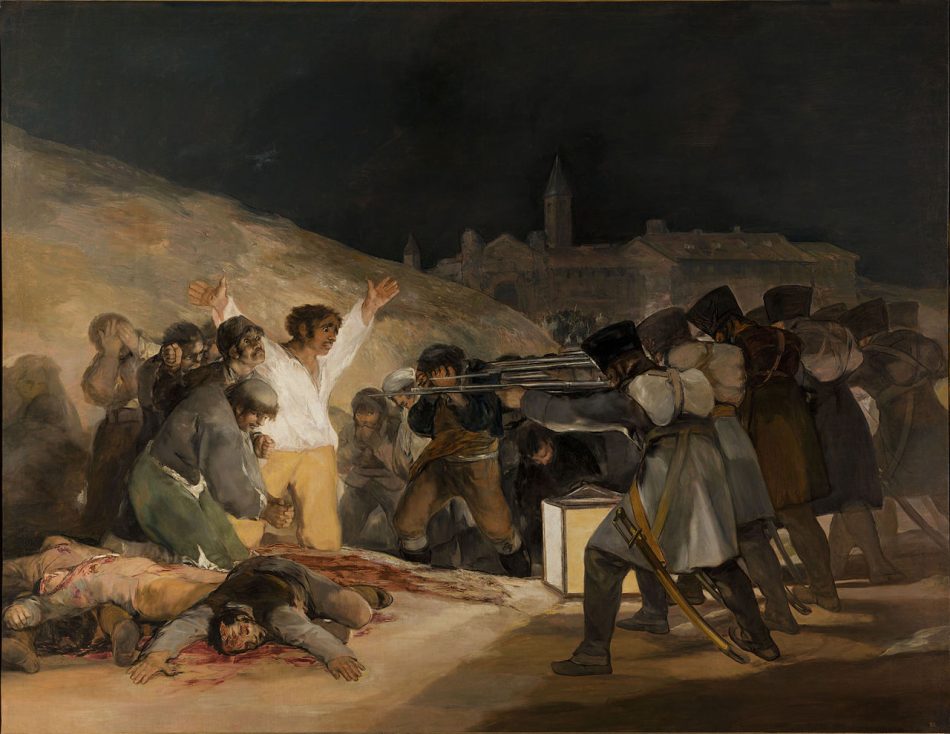Francisco Goya (1746-1828) lived through the end of Spain’s Ancien Régime and his work foretells the development of art in the 20th century, particularly expressionism and surrealism. InSpain.news takes a look at his life and works.
The Prado Museum in Madrid has the greatest collection of Goya works in the world. With nearly 150 paintings and 500 drawings, as well as engravings, the collection is unsurpassable. In the Prado you can trace the development of Goya’s works and his influence on contemporary and later artists.
Goya’s early life
Goya first trained as a painter in Zaragoza under José Luzán for four years, from the age of 14. He moved to Madrid to study with Anton Raphael Mengs, a popular painter with Spanish royalty. They did not get on, and Goya’s examinations were unsatisfactory. Having submitted entries for the Real Academia de Bellas Artes de San Fernando in 1763 and 1766, yet failing to get in, Goya headed to Rome.
At the time, Rome was the cultural capital of Europe and held all the prototypes of classical antiquity. Goya relocated at his own expense. In 1771 he won second prize in a painting competition organised by the City of Parma. That year he returned to Zaragoza and painted elements of the cupolas of the Basilica of the Pillar (including Adoration of the Name of God), a cycle of frescoes for the monastic church of the Charterhouse of Aula Dei, and the frescoes of the Sobradiel Palace. He moved to the studio of Francisco Bayeu.
Goya later married Bayeu’s sister Josefa. Their first child was born in 1774.
Bayeu’s membership of the Academia de Bellas Artes de San Fernando and directorship of the tapestry works from 1777, helped Goya earn commissions to paint cartoons on tapestries for royal residences. These established him at court.
Religious painting
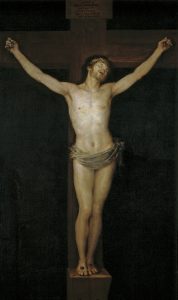
Religious paintings were among Goya’s earliest works, becoming less frequent after 1790. He evolved the style from the more conventional usage of popular devotion to a more intimate and emotive approach. Two examples of this new approach are ‘Christ Crucified’ and ‘St John the Baptist in the Desert’.
Goya returned to religious painting after the Spanish War of Independence, with works including ‘St Justa and St Rufina’ for Seville Cathedral and the dramatic ‘Last Communion of St. Joseph Calasany’.
Royalty and nobility
In 1789, a year after Charles IV’s accession, Goya received the commission of court painter, a position of prestige.
He already had protectors and sponsors among the Spanish aristocracy, such as the dukes and duchesses of Osuna and Alba. However, two crises affected the course of his life.
The first was an illness which left him stone deaf (1793), and the second was the Spanish War of Independence.
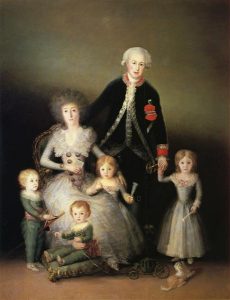
Goya had initially though the French invasion would see the advancement of liberty and rationalism in absolutist Spain, however, he became disenchanted with the rule of Napoleon’s brother. Surviving the cull of court servants when Ferdinand VII returned, Goya remained as court painter for a while. His replacement by the younger Vicente López, saw him withdraw to his inner circle of friends.
An example of his work with the nobility is that of the Duke and Duchess of Osuna and their children (1787-88). The staging was unusual for a portrait in Spain, and Goya may well have been influenced by English works circulating in prints at the time.
Spanish War of Independence
Despite his earlier support of Joseph Bonaparte’s government – in the belief Spain would benefit from French-style liberty – the pain and suffering Goya witnessed became a source of disenchantment.
This disillusion is reflected in ‘Fatal Consequences of the Bloody War in Spain’ and the two canvases commemorating the 2nd and 3rd May 1808.
‘The 2nd May 1808, Madrid’ or ‘The Fight against the Mamelukes’ was painted in 1814 for the newly returned Ferdinand VII. It shows the patriot’s attack against Egyptian soldiers and the Empress’ dragoons. There is so much energy, despair and anger displayed throughout the composition as both sides respond with violence.
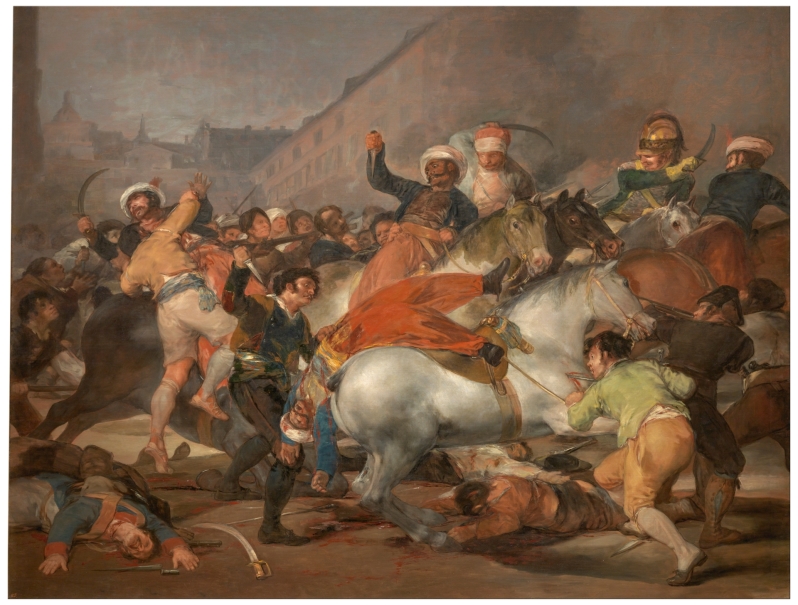
‘The 3rd May 1808 in Madrid’ or ‘The Executions’ (main image) shows the French army shooting the rebels. Traditionally, the painting is set at Mount Principe Pió, ending the revolt. We see the rioters either dead, begging for mercy, cowering in fear or resigned to their fate. The lanternlight illuminates the men’s last moments whilst in the background the church towers of Santa María la Real and San Nicholas rise into the dark skies.
The Black Paintings and Goya’s last works
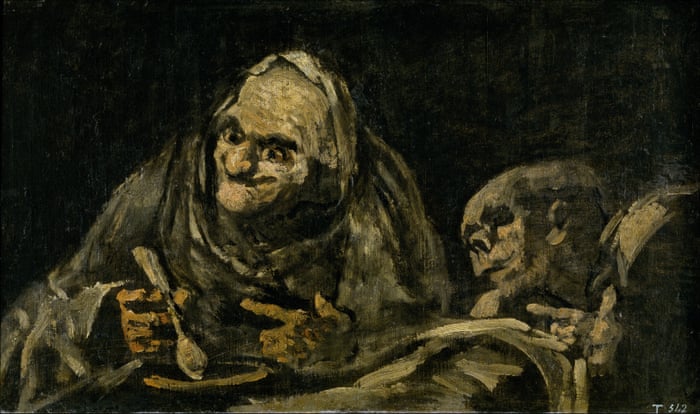
In 1819, Goya bought La Quinta del Sordo (House of the Deaf Man) on the outskirts of Madrid. He decorated the walls of the two main rooms on the grounds and first floors with murals.
The Black Paintings, as now known, seemingly covered landscapes of the villa. They are enigmatic with themes that encapsulate terror, horror, ignorance, death and evil. In 1823, Goya donated the villa to his grandson. In 1873, after several changes of hands, Baron d’Erlanger bought the villa. He commissioned the Prado restorer Salvador Martínez Cubells to transfer the artworks to canvas.
All the Black Paintings have exaggerated attitudes and gestures with energetic brushstrokes. Goya apparnetly painted them with total freedom, without thought for academicism.
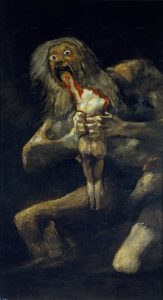 Possibly the most famous of the Black Paintings is Saturn (devouring his son). According to ancient myth, a soothsayer told the Titan Cronus (Saturn in Roman mythology) one of his children would overthrow him. To prevent this, he ate each one upon their birth, until tricked by the mother of his children Rhea, who fed him stones and hid Zeus on Crete. The prediction came true and Zeus overthrew his father.
Possibly the most famous of the Black Paintings is Saturn (devouring his son). According to ancient myth, a soothsayer told the Titan Cronus (Saturn in Roman mythology) one of his children would overthrow him. To prevent this, he ate each one upon their birth, until tricked by the mother of his children Rhea, who fed him stones and hid Zeus on Crete. The prediction came true and Zeus overthrew his father.
As there are no notes to accompany any of the Black Paintings, interpretation is open. Is it a comment on Goya’s relationship with his only surviving child, Xavier? Or the conflict between youth and age, time devouring all things, perhaps the wrath of god? Equally, it could just be Goya’s reworking of Ruben’s picture of the same name.
Time in France and death
Goya left Spain in 1824 and retired to Bordeaux accompanied by Leocadia Weiss. There he completed La Tauromaquia – a series of 33 prints on bullfighting – and other major works.
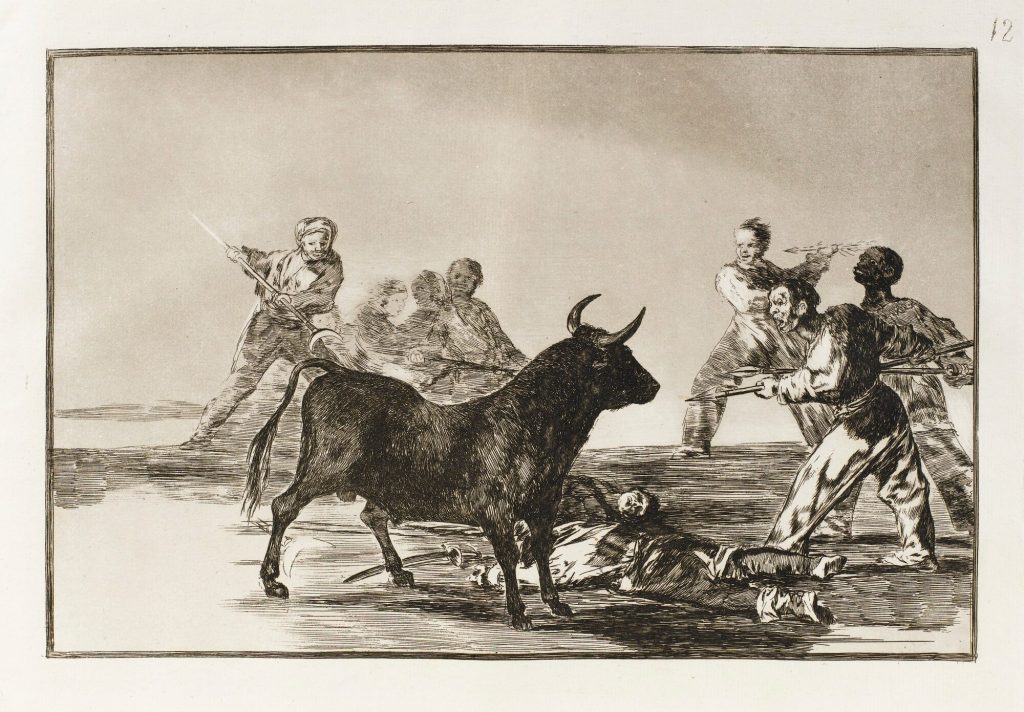
He died on 16th April 1828 following a stroke which left him paralysed on one side.
